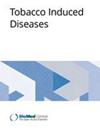关于推广使用质谱分析电子液体中尼古丁、甘油和丙二醇的标准操作程序。
IF 2.2
4区 医学
Q2 PUBLIC, ENVIRONMENTAL & OCCUPATIONAL HEALTH
引用次数: 0
摘要
引言 标准操作程序(SOP)对产品验证至关重要,多个实验室均可使用。EU-JATC(欧洲烟草控制联合行动)标准操作程序和 WHO TobLabNet(世界卫生组织烟草实验室网络)标准操作程序(SOP11)是测量尼古丁、甘油和丙二醇的可用标准方法,并建议用质谱仪(MS)作为火焰离子化检测器(FID)的替代方法。2020 年 5 月,马里奥-内格里农业科学研究所制备了五种测试电子液体的重复样品(A-E),并连同 SOP 11、验证文件和结果数据表发送给来自世界卫生组织 TobLabNet 和欧盟-JATC 的全球 32 个不同实验室(18 个来自 JATC,10 个来自世界卫生组织 TobLabNet,4 个来自学术实验室)。在参与研究的 32 家独立实验室中,有 30 家实验室提供了结果。在接受调查的 30 家实验室中,21 家实验室完全采用了 FID 方法,7 家实验室选择了 MS 检测方法,2 家实验室同时采用了这两种方法。研究结果表明,气相色谱-质谱(GC-MS)方法在尼古丁、甘油和丙二醇的准确度和精确度方面的分析能力与 FID 方法相当。通过皮尔逊相关性检验(r≃1)和学生 t 检验,GC-FID 和 GC-MS 数据之间呈正相关,两种方法之间无显著差异,所有样品中几乎所有三种分析物的 p 均大于 0.005。结论本研究表明,即使在没有 FID 的实验室,也可以应用现有的 EU-JATC SOP 和 WHO TobLabNet SOP11 分析电子烟液体中的香精、痕量化合物或致癌、致突变或生殖毒性(CMR)。本文章由计算机程序翻译,如有差异,请以英文原文为准。
On the extension of the use of a standard operating procedure for nicotine, glycerol and propylene glycol analysis in e-liquids using mass spectrometry.
INTRODUCTION
Standard operating procedures (SOP), accessible to several laboratories, are essential for product verification. EU-JATC (European-Joint Action on Tobacco Control) SOP and the WHO TobLabNet (World Health Organization Tobacco Laboratories Network) SOP (SOP11) are available standard methodologies to measure nicotine, glycerol, and propylene glycol, and propose mass spectrometer (MS) as an alternative method to flame ionization detector (FID). This study conducted a comparison between FID and MS concentration results, following the MS method described in SOP11.
METHODS
In May 2020, five test e-liquids in replicates (A-E) were prepared at the Istituto di Ricerche Farmacologiche Mario Negri and sent, with SOP 11, validation document and results datasheet to 32 different laboratories all over the world from WHO TobLabNet and EU-JATC (18 from JATC, ten from WHO TobLabNet and four academic laboratories). Among thirty-two independent laboratories that participated in the study, results were received from 30 laboratories.
RESULTS
The e-liquids analyses, using the two approaches, were compared. Of the 30 laboratories surveyed, 21 utilized the FID approach exclusively, 7 opted for MS detection, and 2 employed both methods. The findings demonstrated that the gas chromatography-mass spectrometry (GC-MS) method offers comparable analytical capabilities regarding accuracy and precision for nicotine, glycerol, and propylene glycol to the FID approach. Through Pearson's correlation test with r≃1 showing a positive correlation between GC-FID and GC-MS data, and the Student's t-test, no significant differences between the two approaches were revealed, showing p>0.005 for almost all three analytes in all samples.
CONCLUSIONS
This study indicates that it is possible to apply the available EU-JATC SOP and the WHO TobLabNet SOP11 even in laboratories that do not have access to an FID, for example, to analyze flavors, trace compounds or carcinogenic, mutagenic, or toxic for reproduction (CMR) in electronic cigarette liquids.
求助全文
通过发布文献求助,成功后即可免费获取论文全文。
去求助
来源期刊

Tobacco Induced Diseases
SUBSTANCE ABUSE-PUBLIC, ENVIRONMENTAL & OCCUPATIONAL HEALTH
CiteScore
5.30
自引率
5.40%
发文量
95
审稿时长
12 weeks
期刊介绍:
Tobacco Induced Diseases encompasses all aspects of research related to the prevention and control of tobacco use at a global level. Preventing diseases attributable to tobacco is only one aspect of the journal, whose overall scope is to provide a forum for the publication of research articles that can contribute to reducing the burden of tobacco induced diseases globally. To address this epidemic we believe that there must be an avenue for the publication of research/policy activities on tobacco control initiatives that may be very important at a regional and national level. This approach provides a very important "hands on" service to the tobacco control community at a global scale - as common problems have common solutions. Hence, we see ourselves as "connectors" within this global community.
The journal hence encourages the submission of articles from all medical, biological and psychosocial disciplines, ranging from medical and dental clinicians, through health professionals to basic biomedical and clinical scientists.
 求助内容:
求助内容: 应助结果提醒方式:
应助结果提醒方式:


